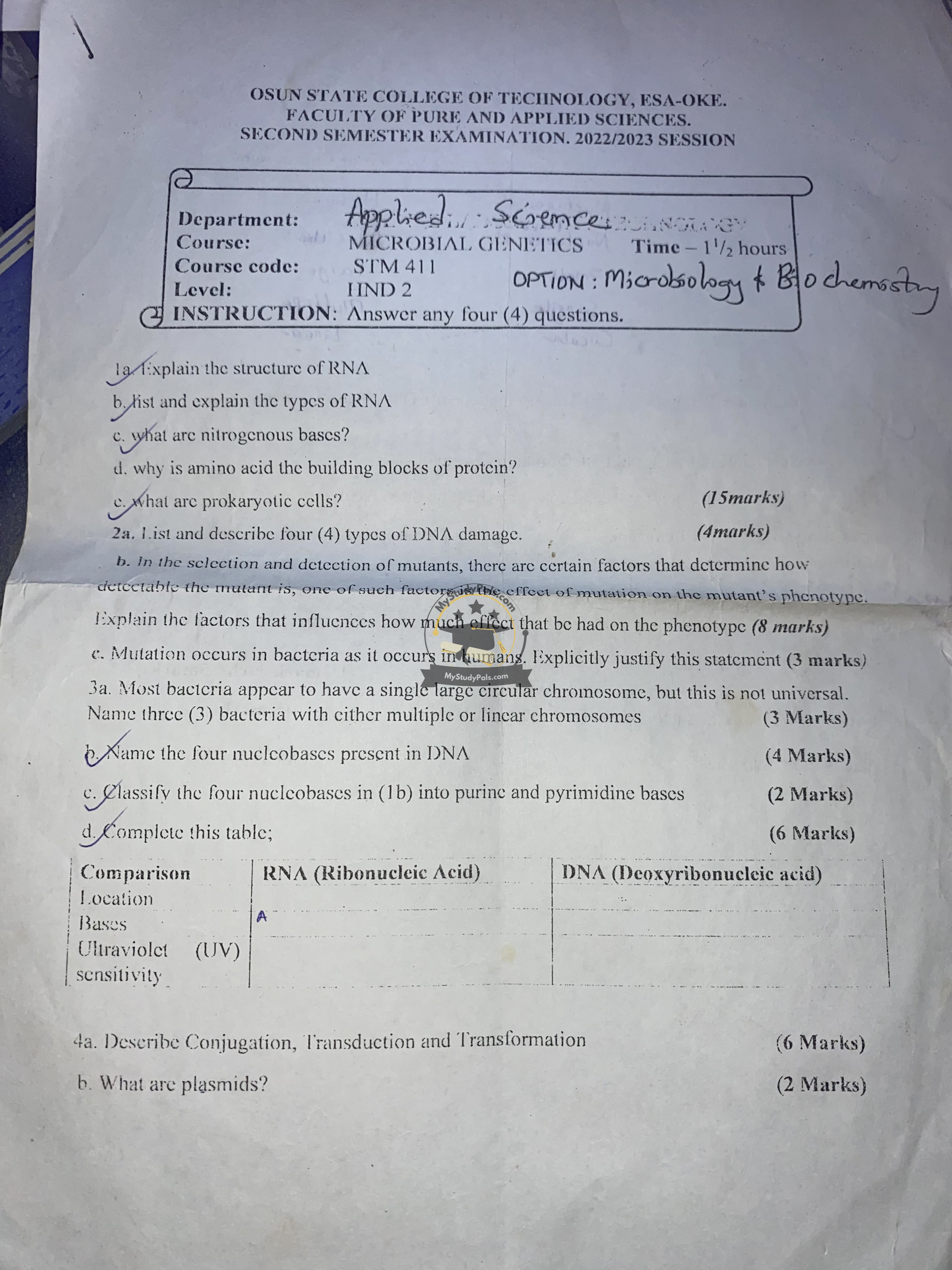ANWSER
Question 1:
a. Explain the structure of RNA
RNA (Ribonucleic Acid) is a single-stranded nucleic acid composed of ribonucleotides. Each ribonucleotide consists of:
- A ribose sugar
- A phosphate group
- A nitrogenous base (Adenine, Uracil, Guanine, Cytosine)
Unlike DNA, RNA contains uracil (U) instead of thymine (T). It has a backbone of alternating sugar and phosphate groups, and the nitrogenous bases extend outward.
b. List and explain the types of RNA
- Messenger RNA (mRNA) – Carries genetic information from DNA to the ribosome for protein synthesis.
- Ribosomal RNA (rRNA) – Forms the core of ribosomes and aids in translation.
- Transfer RNA (tRNA) – Brings amino acids to the ribosome for protein assembly.
- Small Nuclear RNA (snRNA) – Involved in RNA splicing.
- MicroRNA (miRNA) – Regulates gene expression post-transcriptionally.
c. What are nitrogenous bases?
Nitrogenous bases are organic molecules that form the building blocks of nucleotides. They are classified into:
- Purines: Adenine (A) and Guanine (G)
- Pyrimidines: Cytosine (C), Thymine (T) (in DNA), and Uracil (U) (in RNA)
d. Why is an amino acid the building block of protein?
Amino acids are the fundamental units of proteins because:
- They link together via peptide bonds to form polypeptides.
- They determine the structure and function of proteins.
- Proteins are formed by the folding of polypeptide chains into functional structures.
e. What are prokaryotic cells?
Prokaryotic cells are unicellular organisms without a membrane-bound nucleus. Their characteristics include:
- Absence of membrane-bound organelles
- Presence of a single circular chromosome
- Reproduction through binary fission
- Examples: Bacteria and Archaea
Question 2:
a. List and describe four (4) types of DNA damage.
- Base Modifications: Changes in nitrogenous bases due to oxidation or deamination.
- Single-Strand Breaks (SSBs): Breaks in one strand of the DNA, often caused by radiation.
- Double-Strand Breaks (DSBs): Breaks in both strands of DNA, leading to severe mutations.
- Pyrimidine Dimers: UV radiation causes adjacent pyrimidine bases (thymine or cytosine) to form abnormal covalent bonds.
b. How do mutations affect the phenotype?
Mutations can alter gene expression and protein function, leading to changes in an organism’s traits. Some effects include:
- Silent Mutation: No change in protein function.
- Missense Mutation: Change in one amino acid, possibly altering protein function.
- Nonsense Mutation: Introduces a premature stop codon, leading to a truncated protein.
- Frameshift Mutation: Addition or deletion of nucleotides, altering the reading frame.
c. Mutation occurs in bacteria as it occurs in humans. Explicitly justify this statement.
Mutations occur in both bacteria and humans because:
- They result from errors in DNA replication.
- Environmental factors like radiation and chemicals induce mutations.
- Mutations can be beneficial, neutral, or harmful, affecting evolution and adaptation.
Question 3:
a. Name three (3) bacteria with either multiple or linear chromosomes.
- Vibrio cholerae (Two circular chromosomes)
- Borrelia burgdorferi (Linear chromosome)
- Agrobacterium tumefaciens (Two chromosomes, one linear and one circular)
b. Name the four nucleobases present in DNA.
- Adenine (A)
- Thymine (T)
- Guanine (G)
- Cytosine (C)
c. Classify the four nucleobases into purine and pyrimidine bases.
- Purines: Adenine (A), Guanine (G)
- Pyrimidines: Thymine (T), Cytosine (C)
d. Complete the table:
| Comparison | RNA (Ribonucleic Acid) | DNA (Deoxyribonucleic Acid) |
|---|---|---|
| Location | Found in the nucleus and cytoplasm | Found mostly in the nucleus |
| Bases | A, U, G, C | A, T, G, C |
| Ultraviolet (UV) Sensitivity | More sensitive to UV damage | Less sensitive to UV damage |
Question 4:
a. Describe Conjugation, Transduction, and Transformation.
- Conjugation: Direct transfer of genetic material between bacterial cells via a sex pilus.
- Transduction: Transfer of bacterial DNA by bacteriophages (viruses that infect bacteria).
- Transformation: Uptake of free DNA fragments from the environment by a bacterial cell.
b. What are plasmids?
Plasmids are small, circular, double-stranded DNA molecules that exist independently of the bacterial chromosome. They often carry genes for antibiotic resistance, toxin production, or other survival advantages.


